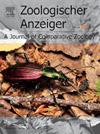生存还是毁灭,这是犀牛群(无尾目:蟾蜍科)中一对前颅骨的性质和正确名称的问题。
IF 1.5
3区 生物学
Q2 ZOOLOGY
引用次数: 0
摘要
在这里,我们重新评估同源性和专有名称的一套头盖骨在水蟾蜍的Rhinella颗粒种组。自2000年以来,这些骨头被称为鼻前骨,但最近的一份出版物提出这些骨头是肥大的鼻中隔。这些元素代表这些蟾蜍头骨中的新骨头的第一个建议出现在20世纪70年代初,但直到1982年才出现正式的描述和命名。我们收集了新的观察结果,主要基于μCT图像,对该组12个已知物种中的6个进行了重新解释和替代描述。尽管处理一小群南美蟾蜍头骨中的一块骨头似乎不重要,但这种描述的相关性可能超出了系统分类学的范畴,因为单系性的证据很丰富。推断结构的形态同源性是适当理解这种结构在群体进化中的作用以及因此而产生的功能的基础。在这些蟾蜍中,鼻前的区域由两块骨头组成,在发育早期与成对的鼻中隔腋窝融合,形成一个突出在前面的元素,形成这些物种独特的吻侧轮廓。在这里,我们对这些骨头进行了重新描述,重新评估了它们在这组蟾蜍中的独特性,并讨论了这个元素最合适的名称。本文章由计算机程序翻译,如有差异,请以英文原文为准。
To be or not to be, that is the question for the nature and proper name for a pair of anterior skull bones in species of the Rhinella granulosa group (Anura: Bufonidae)
Herein we reevaluate the homology and proper name of a set of skull bones in bufonid toads of the Rhinella granulosa species group. Since 2000 these bones have been called prenasals, but a recent publication proposed these bones to be hypertrophied septomaxillae. The first suggestion that these elements represented a new bone in the skull of these toads appeared in the early 1970's, but a formal description and naming did not appear until 1982. We gathered new observations, based primarily on μCT images, of 6 of the 12 known species in the group and present a reinterpretation and alternative description. Although dealing with a single bone present in the skull of a small group of South American toads, for which evidence of monophyly is abundant, may seem unimportant, the relevance of such description may go beyond systematics. Inferring well-based morphological homologies of structures is fundamental for an appropriate understanding of the roles of such structure in the evolution of the group and, consequently, function. In these toads, the area anterior to the nares comprises two bones that, early in development, fuse to the paired septomaxilla, forming an element that protrudes anteriorly to form the distinctive rostral profile of these species. Here we present a redescription of these bones, reevaluate their uniqueness for this group of toads, and discuss the most appropriate name for this element.
求助全文
通过发布文献求助,成功后即可免费获取论文全文。
去求助
来源期刊

Zoologischer Anzeiger
生物-动物学
CiteScore
2.80
自引率
7.10%
发文量
75
审稿时长
>12 weeks
期刊介绍:
Zoologischer Anzeiger - A Journal of Comparative Zoology is devoted to comparative zoology with a special emphasis on morphology, systematics, biogeography, and evolutionary biology targeting all metazoans, both modern and extinct. We also consider taxonomic submissions addressing a broader systematic and/or evolutionary context. The overall aim of the journal is to contribute to our understanding of the organismic world from an evolutionary perspective.
The journal Zoologischer Anzeiger invites suggestions for special issues. Interested parties may contact one of the editors.
 求助内容:
求助内容: 应助结果提醒方式:
应助结果提醒方式:


